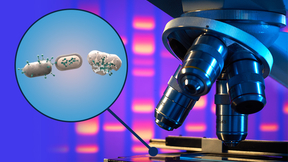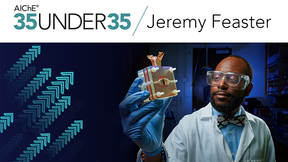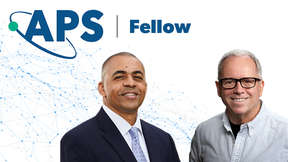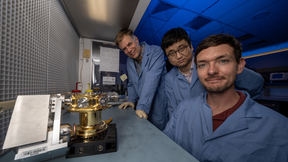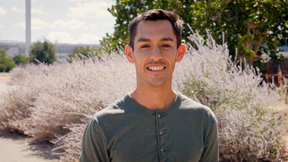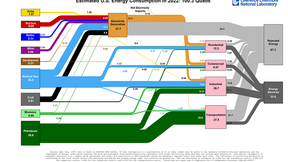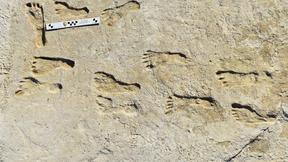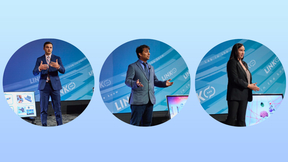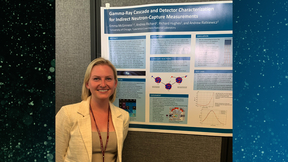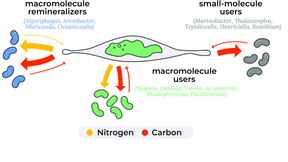Back
Physical and Life Sciences
PROSPECTing new perspective on reactor-produced neutrinos
While neutrinos are one of the most common particles in the universe, their elusive nature makes it challenging to understand their behavior. In new research from the Precision Reactor Oscillation and Spectrum (PROSPECT) Experiment, scientists have produced final results from measurements of neutrinos emitted by a nuclear reactor at the Oak Ridge National Laboratory. Their…
Rewetting of a seasonally dry California grassland soil helps microbe-preying viruses thrive
Beneath the Earth's surface, a relentless conflict unfolds as soil viruses prey on their tiny microbial hosts, fundamentally shaping our planet's ecosystems. New research from Lawrence Livermore National Laboratory (LLNL) scientists and their collaborators at the University of California, Berkeley illuminates a fascinating phenomenon: the demise of soil bacteria and other…
LLNL hosts HBCU students, faculty to build new pipeline of talent
For the second consecutive year, Lawrence Livermore National Laboratory (LLNL) hosted a group of student scholars and faculty members from Historically Black Colleges and Universities (HBCUs) on a recent five-day visit. LLNL’s goal is to develop the next wave of summer interns — and to build a strong pipeline of talent — from historically marginalized groups in science,…
Radiochemistry intern digs deep to prevent the spread of nuclear waste
The groundbreaking discoveries and scientific advancements that take place at Lawrence Livermore National Laboratory (LLNL) and across the broader national laboratory system rely on the passage of information from tenured staff scientists to new interns and early career scientists. This past summer, Zachary (Zach) Murphy, a Ph.D. student studying chemistry at the…
LLNL’s Feaster named to American Institute for Chemical Engineering’s '35 Under 35' class for 2023
Lawrence Livermore National Laboratory staff scientist Jeremy Feaster has been named as one of the American Institute for Chemical Engineering’s (AIChE) “35 Under 35” award winners for 2023. The recognition honors chemical engineers under the age of 35 who have made outstanding contributions to their field and to the chemical engineering community, according to the…
Two LLNL scientists selected as 2023 American Physical Society fellows
Lawrence Livermore National Laboratory (LLNL) scientists Manyalibo “Ibo” Matthews and Frank Graziani have been named 2023 American Physical Society (APS) fellows. Matthews was selected from the Forum in Industrial and Applied Physics unit “for pioneering research in optimizing metal 3D printing and laser materials processing.” Frank Graziani was chosen from the Division of…
Journey to the center of the earth: exploring iron’s equation of state
A typical high-school science class teaches that Earth’s core is comprised of two parts: an inner core that is composed mainly of solid iron and an outer core that is composed mainly of molten, liquid iron. Although this is common knowledge, the location of the boundary between the solid inner core and liquid outer core, as well as many other facets of Earth’s deep…
Lab instrument now on two-billion-mile journey to the metallic asteroid Psyche
An instrument designed and built by Lawrence Livermore National Laboratory (LLNL) researchers departed Earth last week on a two-billion-mile, nearly six-year journey through space to explore a rare, largely metal asteroid. The Livermore high-purity germanium (HPGe) gamma-ray sensor is an essential part of a larger gamma-ray spectrometer (GRS) built in collaboration with…
All eyes on Miguel Cisneros
Miguel Cisneros is a first-generation Mexican American whose journey in life has taken him to explore and navigate the unknown fearlessly. Growing up, Cisneros was an only child who welcomed new adventures. His interest in exploring new experiences and places is something he continues to do to this day. Cisneros’ parents migrated from Mexico to the United States for a…
Wat co-authors article on improving DEI in materials science education
Amy Wat (Materials Science Division) was featured on the cover of the Journal of the Minerals, Metals, & Materials Society (JOM) for her case study on how to improve diversity, equity, and inclusion (DEI) in materials science education. The resulting article, “Cal State LA: An Example for Successful DEI Outcomes for Students,” (pages 13–16) introduces the university’s…
Two selected as Graduate Student Research program recipients
Two graduate students have earned Department of Energy (DOE) Office of Science Graduate Student Research (SCGSR) Program awards to perform their doctoral dissertation research at Lawrence Livermore National Laboratory (LLNL). The prestigious award helps cover living expenses and travel for 60 students from universities across the nation. Their proposed research projects…
National economy continues to reenergize post-pandemic, while pushing toward a new, decarbonized normal
In 2022, Americans used more renewables to generate electricity than in previous years, according to the most recent energy flowcharts and carbon flowcharts released by Lawrence Livermore National Laboratory (LLNL). The nation used 3% more energy, emitted an additional 96 million tons of CO2, but decreased the carbon intensity of U.S. electricity generation by 3.6%,…
In a first, LLNL researchers create birefringent all-glass metasurface
Lawrence Livermore National Laboratory (LLNL) researchers have adapted their novel metasurface process, which creates a thin layer on the surface of an optic, to create an all-glass metasurface with birefringence, or dual refraction, properties. This achievement could transform waveplate technology for high-power laser systems such as the National Ignition Facility (NIF)…
Study confirms age of oldest fossil human footprints in North America
New research reaffirms that human footprints found in White Sands National Park, New Mexico, date to the Last Glacial Maximum, placing humans in North America thousands of years earlier than once thought. In September 2021, U.S. Geological Survey researchers and an international team of scientists announced that ancient human footprints discovered in White Sands National…
PLS postdocs excel at the 2023 Research Slam
On Thursday, August 24, a dozen LLNL postdocs presented in the annual Postdoctoral Research Slam, answering the question “Why is my research important?” in only three minutes. Each talk was then evaluated by LLNL leadership, awarding first and second place to PLS postdocs Brandon Zimmerman and Aditya Prajapati, respectively. As a bonus, the attending audience voted on…
Summer student work helps calculate neutron-capture reactions
Neutron-capture reactions on unstable nuclei play a key role in the production of heavy elements in the universe and provide vital diagnostics for reaction networks related to stockpile stewardship. However, these reactions cannot be measured directly because they involve radioactive nuclei. Lawrence Livermore researchers have performed indirect measurements to constrain…
Lawrence Livermore grabs two spots in DOE’s Energy Earthshot program
Lawrence Livermore National Laboratory (LLNL) scientists will lead and co-lead projects in support of the Department of Energy’s (DOE) new Energy Earthshot program. The Energy Earthshots Initiative calls for innovation and collaboration to tackle the toughest topics in energy-related research. In January, DOE announced Office of Science funding for the Energy Earthshot…
LLNL scientists use engineered bone marrow for cancer research and treatment
Osteosarcoma (OS) is the most common primary malignant bone cancer in children and adolescents. While many other cancers now have promising therapeutic advances, treatment options for OS have remained unchanged since the introduction of standard chemotherapeutics and offer less than a 25% five-year survival rate for those with metastatic disease. Now, Lawrence Livermore…
Not all bacteria are created equal
Lawrence Livermore National Laboratory (LLNL) scientists have found that bacteria can help algae make carbon-neutral biofuels or draw down additional carbon from the atmosphere if the conditions are just right. The team used LLNL’s nanoSIMS to understand and quantify the role of the algal microbiome in processing algal carbon (C) and nitrogen (N). The research appears in…
Unlocking gas phase uranium oxidation is key to nuclear debris modeling
In the quest to understand how nuclear debris forms, a team of scientists at Lawrence Livermore National Laboratory (LLNL) has developed an approach to studying the oxidation mechanism of gas phase uranium in extreme environments. In research recently published in Scientific Reports, the team outlined their work, which combined experimental data from a plasma flow reactor …



